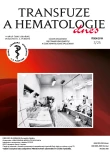External quality control of CD34+ cell assessment in Czech and Slovak Republic – long-term experience from eight years
Authors:
D. Lysák 1; M. Budina 2; M. Holubová 1,3; P. Jindra 1
Authors‘ workplace:
Hematologicko-onkologické oddělení Fakultní nemocnice Plzeň
1; SEKK, spol. s r. o., Pardubice
2; Biomedicínské centrum LF Plzeň
3
Published in:
Transfuze Hematol. dnes,25, 2019, No. 3, p. 258-263.
Category:
Original Papers
Overview
Determination of CD34+ cells by flow cytometry is a basic method for assessing the quality of hematopoietic stem cell grafts and for planning their collection by leukapheresis. This method is based on multiparameter flow cytometry and is well-standardized internationally. The EQA program for CD34 + quantification has been available in the Czech and the Slovak Republic since 2010 with more than 20 laboratories involved. Evaluation of the 8-year experience has shown an excellent long-term success of participating laboratories ranging between 80–100 %, with sporadic fluctuations. Some of the participants who have been involved in the program from the beginning, achieve even 90% success rates. Reproducibility of measurement results is highly dependent on the amount of CD34+ cells in the sample. CV oscillates around 10 % if the CD34+ count is 10/μL or higher and increases by dozens of percent below this level. The program plays an important role in harmonizing CD34+ determination between transplant centres and increases the likelihood of obtaining accurate and comparable results.
Keywords:
variability – quality control – CD34+ – EQA
Sources
1. Allan DS, Keeney M, Howson-Jan K, et al. Number of viable CD34+ cells reinfused predicts engraftment in autologous hematopoietic stem cell transplantation. Bone Marrow Transplantation 2002;29:967–972.
2. Gratama JW, Sutherland DR, Keeney M. Flow cytometric enumeration and immunophenotyping of hematopoietic stem and progenitor cells. Semin Hematol 2001;38:139–147.
3. Apperley J, Carreras E, Gluckman E, Masszi T, et al. Haematopoietic stem cell transplantation. The EBMT Handbook. 6. vyd. Janov, Forum service editore, 2012:93.
4. Sutherland DR, Anderson L, Keeney M, Nayar R, Chin-Yee I. The ISHAGE guidelines for CD34+ cell determination by flow cytometry. J Hemother 1996;5:213–226.
5. Gutensohn K, Carrero I, Krueger W, et al. Semi-automatic flow cytometric analysis of CD34 expressing hematopoietic cells in peripheral blood progenitor cell apheresis products. Transfusion 1999;39:1220–1226.
6. Barnett D, Granger V, Kraan J, et al. Reduction of intra- and interlaboratory variation in CD34+ stem cell enumeration using stable test material, standard protocols and targeted training. Br J Haematol 2000;108:784–792.
7. Dzik W, Sniecinski I, Fischer J. Toward standardization of CD34+ cell enumeration: An international study. Transfusion 1999;39:856–863.
8. Gratama JW, Kraan J, Levering W, Van Bockstaele DR, Rijkers G, Van der Schoot CE. Analysis of variation in results of CD34þ hemato-poietic progenitor cell enumeration in a multicenter study. Cytometry 1997;30:109117.
9. Barnett D, Granger V, Whitby L, et al. Absolute CD4+ T-lymphocyte and CD34+ stem cell counts by singleplatform flow cytometry: the way forward. Br J Haematol 1999;106:1059–1062.
10. Eidenschink L, DiZerega G, Rodgers K, Bartlett M, Wells DA, Loken MR. Basal levels of CD34 positive cells in peripheral blood differ between individuals and are stable for 18 months. Cytometry B Clin Cytom 2012;82:18–25.
11. Levering W, Preijers F, van Wieringen W, et al. Flow cytometric CD34+ stem cell enumeration: lessons from nine years’ external quality assessment within the Benelux countries. Cytometry Part B 2007;72B:178–188.
12. Gratama JW, Kraan J, Keeney M, Sutherland DR, Granger V, Barnett D. Validation of a single-platform ISHAGE method for CD34+ hematopoietic stem cell and progenitor cell enumeration in an international multicenter study. Cytotherapy 2003;5:55–65.
Labels
Haematology Internal medicine Clinical oncologyArticle was published in
Transfusion and Haematology Today

2019 Issue 3
- Administration of aPCC as a Prevention of Bleeding After Major Cardiac Surgical Procedures
- The Importance of Hydration in Wound Healing
- Cost Effectiveness of FVIII Substitution Versus Non-Factor Therapy for Hemophilia A
- Vascular Disease in the Gradually Aging Population of Hemophiliacs: An Underestimated Problem?
- Prognostic Significance of Subclinical Joint Changes on MRI in Hemophilia
Most read in this issue
- Osteonecrosis of the jaw, atypical fractures and other less frequent adverse events associated with bisphosphonates
- Revaccination of adult patients following allogeneic haematopoietic stem cell transplantation: CELL recommendations
- Pharmacokinetics in haemophilia treatment
- Sirolimus – alternative treatment for warm antibody hemolytic anaemia (WAIHA)
